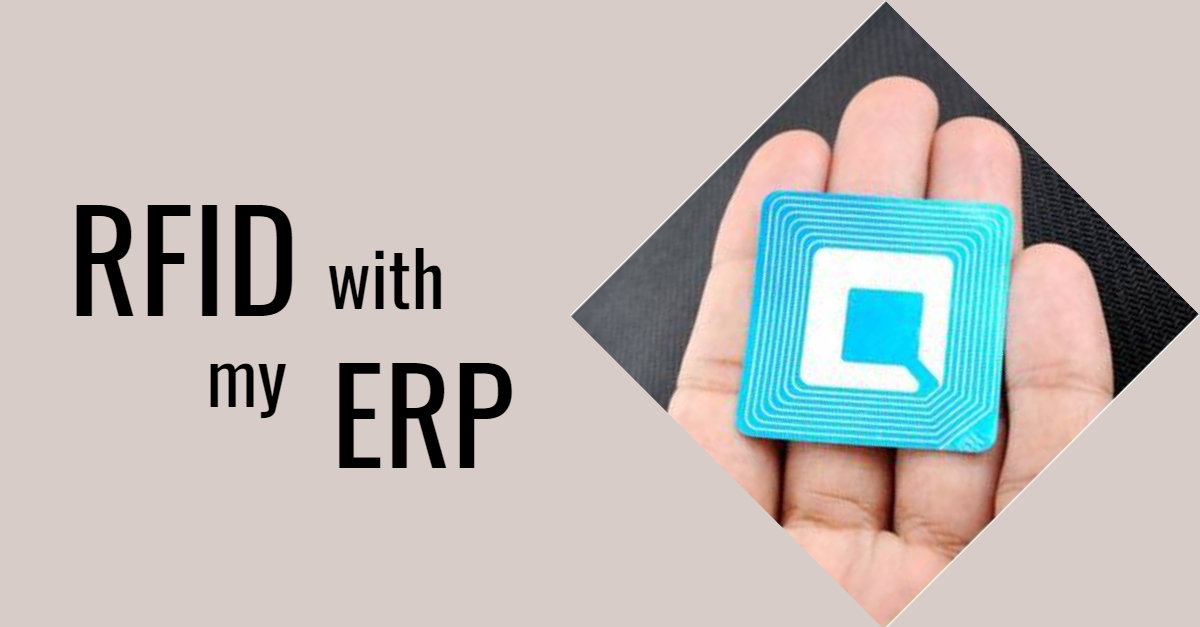Since my earliest experiences in the nineties (yes, I’m getting old) ERP solutions and RFID technologies, have typically operated as separate “silo” solutions. While they may have some overlap in their missions, they’ve functioned independently. As a result, neither reaps the benefits of the other – and you don’t get to see what the combination could do.
But I’m getting ahead of myself. Both “ERP” and “RFID” usually come with a set of pre-conceived beliefs for many people – especially the latter. RFID is pretty impressive – but does it really work?
RFID at Work
When discussing RFID with a prospect, one of the frequent challenges we have is a common “all or nothing” perception for the use of RFID. In fact, sometimes they have already selected RFID as the technology to solve their problem(s) – before really looking at all aspects of the problem – and now they want assistance to create the physical solution (application, hardware, tags, etc.) – to support that choice.
Regardless of how they arrive at RFID, the conceived approach is almost always a “standalone” or “closed-loop” solution. This just adds another single solution to an organization’s IT suite, instead of looking at integrating with key applications that you may already have in place.
RFID is an excellent technology that can offer huge benefits when leveraged correctly against your business objectives where it fits. Here are some of the primary reasons to use RFID:
- Hands Free Capture – Captures data without actually needing a human
- Bulk Capture – Captures numerous pieces of information simultaneously
- Out-of-Sight Capture – Captures information when you’re nearby, but can’t physically see the item
While there are many reasons to use RFID, these three have been the bulk of our exposure over the past 20 years. Each can deliver tremendous value to any solution – where they compliment the business goals.
Since we focus principally on Supply Chain and Asset Management, here are how these three factors have provided most powerful benefits when we’ve leveraged RFID:
Supply Chain
The biggest use and greatest value of RFID in our Supply Chain solutions has been in the transition of materials (from one location to another, hands free). Another is validation that all materials are together (bulk capture) prior to an action like Shipping or Receiving.
Asset Management
Using RFID with Asset Management solutions has offered the bulk of successful results for this technology. Asset Management is all about capture and validation of items for financial, compliance or security requirements and reporting. RFID expedites things with rapid confirmation (out-of-site capture) of items existing in a general area in an expedited manner (bulk capture).
So what does this have to do with my ERP?
While the use and success of RFID (and ERPs, for that matter) has been achieved a number of times, each is generally implemented in a separate solution. The RFID data is captured, managed and used in its own specific application and ERPs are focused at a more global, administrative level functions.
But what if you combined the strength of RFID with the broad reach of your ERP? RFID could slide into activities where information needs to be captured and automate the feed of this data into the appropriate areas of your ERP.
Since Asset Management is in our wheelhouse, I’ll give you an example of what RFID/ERP could look like from that perspective.
Periodically, you need to report on your organizations assets for your financial reports, right? That usually starts with getting existing inventory information from your ERP. Then someone or some team on your staff takes that information and goes out across your facilities and confirms/adds/edits that data (ideally – I’m sure your team wouldn’t just give the list that once-over and approve…that never happens…). Capturing the information might require going from room to room, checking the back of computers, crawling under desks and so on – fun stuff.
Now add RFID. Without changes at all in how you initiate or reconcile an inventory event within your ERP, you can take advantage of automating the data capture aspects of this task. Not a bad plan, huh? The application on the handheld computer will take advantage of capturing any asset data that uses an RFID tag, and will then transmit it to the ERP automatically – similar to barcode-captured data. Your inventory task just went from clipboards, crawling under desks and manual data entry to scan and transmit.
Obviously, there are factors to consider that influence things – like getting your assets tagged, matching the right type of tag with the asset, handling RFID tagged assets with barcode tagged assets, etc. That’s just where solid design and planning comes in. That up-front effort is worth it when you consider the results. Going back to our Asset Management example, here’s just a few of the benefits:
- Your existing procedures and data with your ERP tables don’t require any changes.
- It’s not all or nothing – you don’t have to have only RFID – or only barcode. Assets can have either type of tag.
- Inventory practices can remain the same – the handheld navigates between barcode scanner and RFID reader.
Still wondering about the benefits? A case study that was performed by one of my customers used RFID in a classroom where we had 84 items (computers, furniture, cartons, etc.) tagged.
The results were:
- 8 ½ minutes to complete with barcode scanning
- ˂ 1 minute with RFID (2 passes)
- 100% confirmation in both options
RFID isn’t for everyone or everything, but definitely don’t rule it out for use with your ERP. The key to a successful combination is to first establish the business case and goals – and then look at your options for meeting those goals. You may be surprised how combining RFID with your ERP could result in substantial impacts – for a much lower effort that you might think.
Curious about how it could work for you? Let’s talk.




